kent island
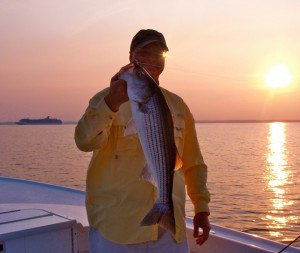 Channel catfish at Hackett’s Bar, carp at the Bay Bridge, snakeheads in St. Jerome’s Creek, and very few stripers in their usual haunts around Kent Island – what’s up with all this late-spring craziness in the Chesapeake Bay? Most fishermen are blaming salt, or more specifically, a lack thereof. Very wet weather in the Susquehanna River watershed has meant lots of fresh water entering the Bay. It’s highly unusual for the Bay to be this fresh in June. Some stations are reporting the lowest readings in recorded history. Salinity is expressed in parts per thousand (ppt), in other words, the number of grams of dissolved salts present in 1,000 grams of water. The water in the Atlantic Ocean is about 35 ppt. Surface salinity today at the Gooses Reef Buoy in the Mid-Chesapeake Bay is 2.0 ppt. That’s low! For better striped bass fishing, we need more salt.
Channel catfish at Hackett’s Bar, carp at the Bay Bridge, snakeheads in St. Jerome’s Creek, and very few stripers in their usual haunts around Kent Island – what’s up with all this late-spring craziness in the Chesapeake Bay? Most fishermen are blaming salt, or more specifically, a lack thereof. Very wet weather in the Susquehanna River watershed has meant lots of fresh water entering the Bay. It’s highly unusual for the Bay to be this fresh in June. Some stations are reporting the lowest readings in recorded history. Salinity is expressed in parts per thousand (ppt), in other words, the number of grams of dissolved salts present in 1,000 grams of water. The water in the Atlantic Ocean is about 35 ppt. Surface salinity today at the Gooses Reef Buoy in the Mid-Chesapeake Bay is 2.0 ppt. That’s low! For better striped bass fishing, we need more salt.
Fishermen have long recognized the importance of locating comfort zones where fish prefer to stay, but sometimes that isn’t so easy. Fishing in late May and early June is usually a challenge, but low salinity levels have made it especially difficult this year. Complicating the matter is that he water can be a lot saltier on the bottom of the Bay than it is on top this time of year. Since, in addition to surface observations, The Gooses Reef Buoy also provides salinity readings from the bottom of the Bay, we can see that it’s currently 7.1 ppt. That’s over three times saltier than it is on the surface. Read More!
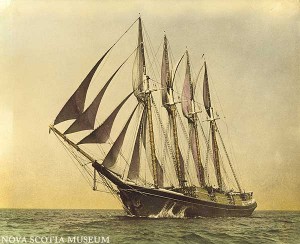 At 7:00 PM on the evening of March 15th, 1912, the four-masted schooner Herbert D. Maxwell left her anchorage near the mouth of the Magothy River and sailed southeast across the Chesapeake Bay toward Kent Island. Built in Maine and designed to haul lumber, the 186 foot cargo ship carried 1150 tons of fertilizer from Baltimore bound for Wilmington, North Carolina. At her helm was her captain and master, William Quillan accompanied by his brother Elay and first mate J.C. Scott. She carried an additional crew of six deck hands. Since winds were mostly calm, it had been slow going down the Chesapeake. After a drowsy sail to just south of Sandy Point, the wind completely died causing Captain Quillan to drop anchor once again. The crew slept until roused by a building northeast breeze at 3:00 AM. Quillan gave the order to the mate to get underway. After pulling anchor and setting sail, The Maxwell ran under clear skies before a 15-knot wind for about 40 minutes when her lookout made an ominous call, “Lights of a steamer, dead-on ahead!” Three minutes later, at 4:44 AM on March 16th, the wooden schooner was ripped apart by the 3200-ton northbound steamship S.S. Gloucester. She sank quickly carrying the first mate and three other crew members to their deaths. Read More!
At 7:00 PM on the evening of March 15th, 1912, the four-masted schooner Herbert D. Maxwell left her anchorage near the mouth of the Magothy River and sailed southeast across the Chesapeake Bay toward Kent Island. Built in Maine and designed to haul lumber, the 186 foot cargo ship carried 1150 tons of fertilizer from Baltimore bound for Wilmington, North Carolina. At her helm was her captain and master, William Quillan accompanied by his brother Elay and first mate J.C. Scott. She carried an additional crew of six deck hands. Since winds were mostly calm, it had been slow going down the Chesapeake. After a drowsy sail to just south of Sandy Point, the wind completely died causing Captain Quillan to drop anchor once again. The crew slept until roused by a building northeast breeze at 3:00 AM. Quillan gave the order to the mate to get underway. After pulling anchor and setting sail, The Maxwell ran under clear skies before a 15-knot wind for about 40 minutes when her lookout made an ominous call, “Lights of a steamer, dead-on ahead!” Three minutes later, at 4:44 AM on March 16th, the wooden schooner was ripped apart by the 3200-ton northbound steamship S.S. Gloucester. She sank quickly carrying the first mate and three other crew members to their deaths. Read More!
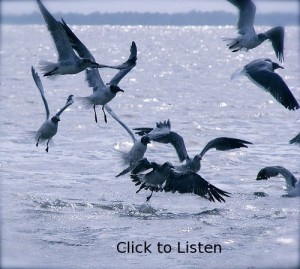 Radios blaring, airplanes buzzing, stereos thumping, outboards droning, helicopters whirring, sirens wailing – Wow! I spent a lot of my time on the water this weekend just listening. Boat shows, trolling tournaments, and sailing regattas made the main stem of the Chesapeake very noisy. The Bay is fully awake from her winter slumber and the crowds are back in force. While we each enjoy the water in our preferred ways, to my thinking fishing should include elements of solitude and stealth. I don’t know about you, but I’d rather pick up aluminum cans at rush hour along I-95 than try to pick off rockfish in the main channel on a busy weekend. I prefer to look off the beaten path for places where I can tune-in to something a little more pleasing than the clamorous dissonance of the masses. At this busy time of the year, I want to listen for the sounds of laughter.
Radios blaring, airplanes buzzing, stereos thumping, outboards droning, helicopters whirring, sirens wailing – Wow! I spent a lot of my time on the water this weekend just listening. Boat shows, trolling tournaments, and sailing regattas made the main stem of the Chesapeake very noisy. The Bay is fully awake from her winter slumber and the crowds are back in force. While we each enjoy the water in our preferred ways, to my thinking fishing should include elements of solitude and stealth. I don’t know about you, but I’d rather pick up aluminum cans at rush hour along I-95 than try to pick off rockfish in the main channel on a busy weekend. I prefer to look off the beaten path for places where I can tune-in to something a little more pleasing than the clamorous dissonance of the masses. At this busy time of the year, I want to listen for the sounds of laughter.
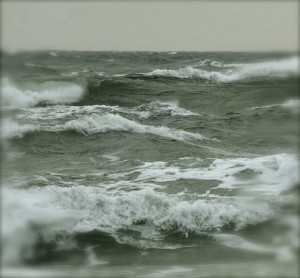 At least they must have been precious in his sight last weekend when an epic spring storm kept many fishermen off the Bay on the opening day of Maryland’s striped bass catch-and-kill season. Water temperatures are lower than usual this April, so there are lots of pre-spawn fish still moving up the Bay. I’d guess at least a couple of thousand more roe-laden cows made it to the spawning grounds this weekend that otherwise wouldn’t have, but for the storms. Let’s hope that translates into millions of additional baby rockfish. Even though I usually root for the fish, I still get excited about opening weekend because the recreational rockfish season in Maryland is definitely worth celebrating. With all the commercial poaching we saw this winter, it’s amazing to me that there are any fish left to catch. Since there are still a few around, let’s thank the Lord for that too!
At least they must have been precious in his sight last weekend when an epic spring storm kept many fishermen off the Bay on the opening day of Maryland’s striped bass catch-and-kill season. Water temperatures are lower than usual this April, so there are lots of pre-spawn fish still moving up the Bay. I’d guess at least a couple of thousand more roe-laden cows made it to the spawning grounds this weekend that otherwise wouldn’t have, but for the storms. Let’s hope that translates into millions of additional baby rockfish. Even though I usually root for the fish, I still get excited about opening weekend because the recreational rockfish season in Maryland is definitely worth celebrating. With all the commercial poaching we saw this winter, it’s amazing to me that there are any fish left to catch. Since there are still a few around, let’s thank the Lord for that too!
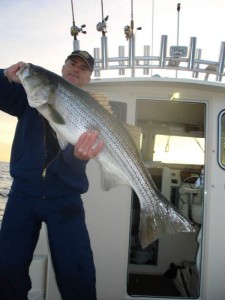 Maybe I’m getting better, but more likely I just got lucky. Either way, I called this last pattern change pretty close. As the water cools, big fish move closer to the main channel of the Chesapeake Bay. There’s still plenty of smaller fish in the rivers and the nearby flats, but since it’s late November and the season for trophies, it’s time to lock in on the channel. Here are two good reasons: Number one – water temperature. Striped bass prefer water that is warmer than 50 degrees. Surface temperatures right now in most of the Maryland section of the Chesapeake Bay are in the low 50s. Since the deeper water near the channel can be ten degrees warmer than it is in the rivers, stripers will stay closer to their comfort zone. You’ll see them holding very close to the bottom on the fish finder. They will still move up shallow to eat, but they’ll go right back to the deeper water to rest between feeding frenzies.
Maybe I’m getting better, but more likely I just got lucky. Either way, I called this last pattern change pretty close. As the water cools, big fish move closer to the main channel of the Chesapeake Bay. There’s still plenty of smaller fish in the rivers and the nearby flats, but since it’s late November and the season for trophies, it’s time to lock in on the channel. Here are two good reasons: Number one – water temperature. Striped bass prefer water that is warmer than 50 degrees. Surface temperatures right now in most of the Maryland section of the Chesapeake Bay are in the low 50s. Since the deeper water near the channel can be ten degrees warmer than it is in the rivers, stripers will stay closer to their comfort zone. You’ll see them holding very close to the bottom on the fish finder. They will still move up shallow to eat, but they’ll go right back to the deeper water to rest between feeding frenzies.
The second reason to fish near the channel is bait. Larger fish want bigger bait. The most common baitfish of any consequence in the Bay right now is menhaden. Since they migrate toward warmer water just like rockfish, by late November they are well on their way toward their comfort zones farther south. That means there is less and less bait in the upper reaches of the Bay and the biggest concentrations of menhaden are now near the channel. That’s perfect conditions for big stripers because they can hang out in the deeper warmer water and still ambush big bait. That doesn’t mean they’ll bite anything you throw at them though. Well, maybe the smaller fish will, but there’s a secret to getting the trophies. Read More!
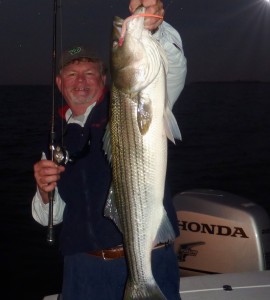 There’s a blue moon shining
There’s a blue moon shining
When I am reminded of all we’ve been through
Such a blue moon… shining
Does it ever shine down on you? -Nanci Griffith
I guess you could say my wife and I met on a blue moon. It was at least a rare occasion, one that I’ll never regret because, among other great things, it ultimately led me to the Chesapeake Bay. There’s some discussion about what makes a moon blue these days. The modern interpretation is that the blue moon is the second full moon in any given month, but there’s an older interpretation I like better. There are normally three full moons in each season whether spring, summer, fall, or winter, but sometimes, rarely, there is an extra full moon. Farmers and fishermen who plan their lives by the seasons refer to the usual full moon cycles in a three-name seasonal sequence – for example the early summer moon, mid summer moon, or late summer moon. The late moon is always the last of the season, so when that rarely occurring extra full moon comes along, it is left without a name. We call it the blue moon. That makes tonight, Sunday November 21st the blue moon of fall 2010. You can read more about it in this Space.com article. Since the phases of the moon drastically influence the tidal currents in the Chesapeake Bay, I pay very close attention. Read More!


